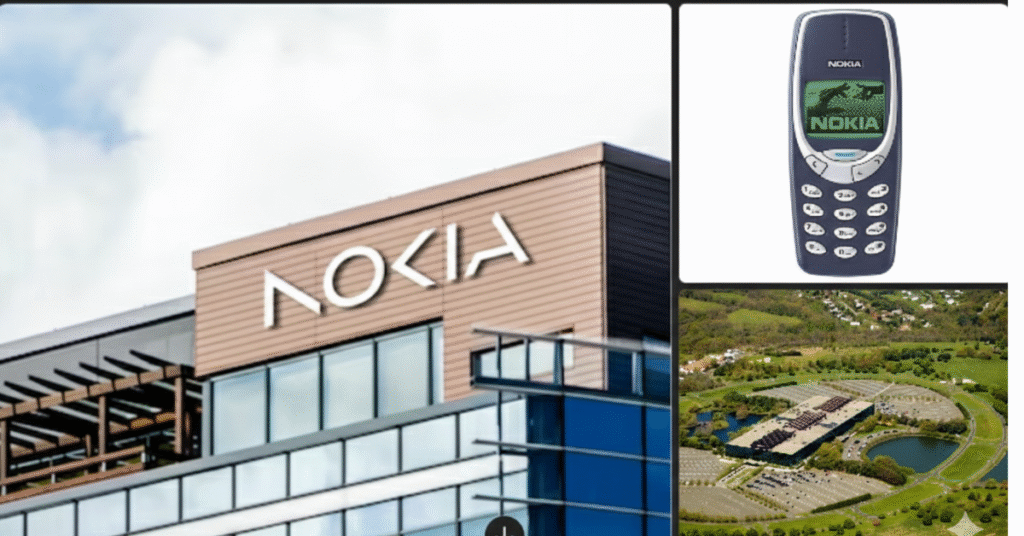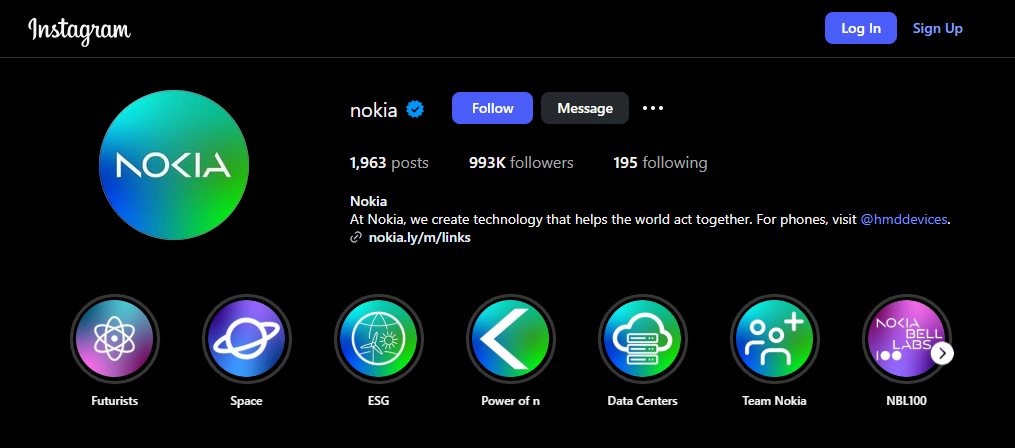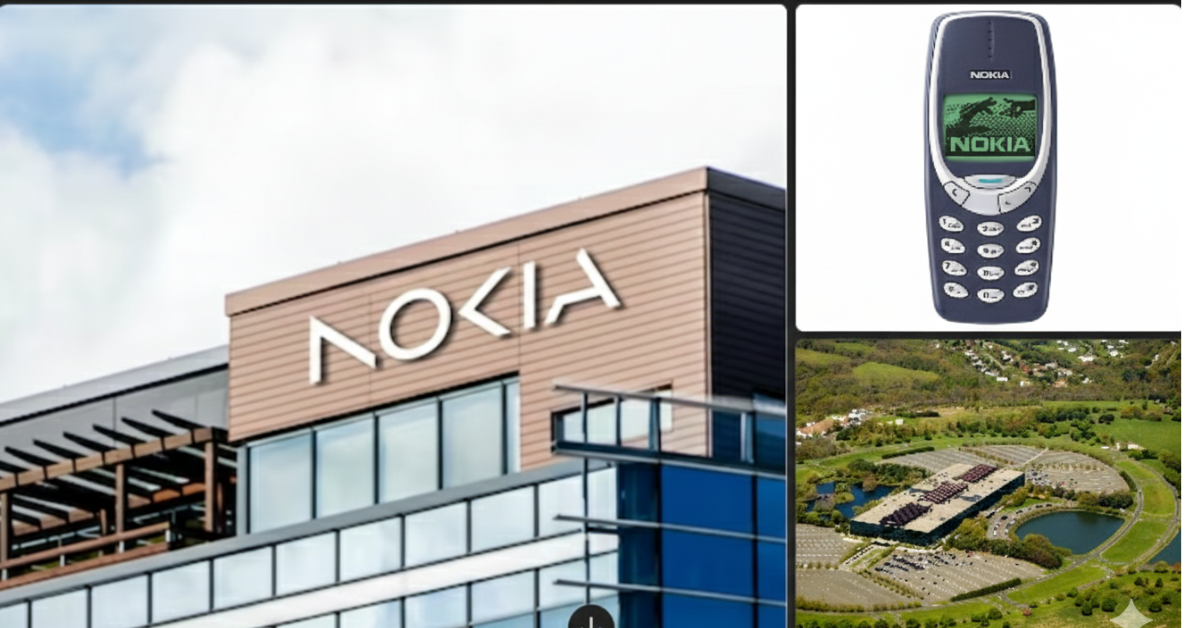Nokia Corporation, a Finnish company now known primarily for telecommunications infrastructure and mobile-network technology, has a fascinating journey spanning over 150 years. What began as a small paper mill near the town of Nokia (in Finland) evolves into a global innovator in mobile phones, network equipment, and cutting-edge research. This article provides a deep, discover-friendly, SEO-optimized, and user-helpful look at Nokia: its history, rise, fall in mobile, resurgence in infrastructure, current strategy, key challenges, and what is ahead.

1. Origins: 1865 to Mid-20th Century
- Nokia’s story starts in 1865, when engineer Fredrik Idestam founded a pulp mill near Tampere, Finland.
- By the 1900s, the company diversified: in 1898 the Finnish Rubber Works (manufacturing boots and tires) and in 1912 Finnish Cable Works joined forces with what became Nokia, forming the multi-business conglomerate.
- In 1967 Nokia Corporation was formed as a merger of the pulp business, cable works, rubber works and other operations.
- During the mid-20th century, Nokia moved into electronics, telecommunications equipment, and cables—a major pivot from its paper/rubber origins.
User takeaway: Nokia’s long history shows a pattern of reinvention. The lesson: large legacy companies can thrive only by transforming.
2. Rise to Mobile Supremacy: 1980s-2000s
- Nokia was deeply involved in early mobile telephony: for example, it contributed to the Nordic Mobile Telephony (NMT) 1G analog network in 1981.
- In the 1990s, as digital mobile networks (GSM) grew, Nokia capitalised heavily, launching handsets like the Nokia 1011 (1992), Nokia 2110 (1994) and others.
- By 1998, Nokia overtook Motorola as the world’s largest mobile-phone manufacturer.
- At its peak (circa early 2000s), Nokia’s brand was ubiquitous, especially in emerging markets and in feature phones.
Important features of this era:
- Strong hardware design and user experience.
- Focus on mid-level markets around the world (emerging economies).
- Deep control of manufacturing and supply chain.
User takeaway: Nokia’s dominance came from good timing, strong global reach and simplicity in handsets. For businesses: global scale + local relevance can win.
Instagram ID : nokia

3. The Fall of the Mobile Handset Empire
- Around late 2000s and early 2010s, Nokia struggled to transition from feature phones to smartphones.
- The Symbian platform, once dominant, failed to keep up with Android and iOS evolution. Wikipedia
- In 2014, Microsoft acquired Nokia’s devices business for about US$7.2 billion. TIME+1
- After the sale, Nokia’s handset presence faded and it refocused on network equipment and infrastructure. Wikipedia+1
User takeaway: Even market leaders can decline if they miss structural shifts (here: smartphone revolution). Attention to trends matters more than past success.
4. Reinvention: From Handsets to Networks & Patents
- Nokia pivoted strongly into telecommunications infrastructure, services, patents and licensing. Wikipedia+1
- The acquisition of Alcatel‑Lucent (including Bell Labs) bolstered Nokia’s R&D and networks business. Nokia Corporation | Nokia+1
- Nokia Bell Labs, with its long history of innovation (including transistors, solar cells, information theory) continues as a research powerhouse. Nokia Corporation | Nokia+1
- Nokia became a major patent licensor for mobile phone makers and a dominant player in network equipment. Wikipedia+1
Key lesson: Old firm capabilities (eg engineering, patents) can be leveraged into new domains (networks, licensing) after mainstream product decline.
5. Current Business & Strategy (2020s)
a) Business Segments
- Networks: mobile and fixed networks, including 5 G infrastructure, private wireless, optical transport.
- Technology licensing and patents: royalties from handset makers and others.
- Software and services: network automation, cloud-native communications.
- Emerging segments: 6G research, IoT, industrial connectivity, moon/space networks.
b) Key recent news that shape Nokia today:
- Nokia signed a multi-year expansion deal with AT&T for voice carriage and 5G network automation in the U.S. (2025) — signalling heavy infrastructure bets.
- Nokia appointed Justin Hotard, former Intel AI & Data Center head, as CEO in April 2025, emphasising AI/data centre growth strategy.
c) Strategic focus areas
- 5G and 6G roll-out: As mobile network evolution continues, Nokia wants to be a major global supplier despite fierce competition from Ericsson and Huawei.
- Optical and data centre networks: The demand for cloud, streaming, AI large-scale compute drives optical transport investments (e.g., acquisition of Infinera).
- Enterprise / private wireless: Industries like manufacturing, ports, mining are adopting private 5G + IoT networks — Nokia aims to capture that.
- Research leadership: Bell Labs working on next-gen communications (eg lunar networks, quantum, massive MIMO).
User takeaway: Nokia has successfully transformed from consumer electronics to critical network infrastructure and research, making it relevant in the 2020s digital-economy.
6. Nokia in Mobile Devices Today
- Although Nokia’s core business moved away from manufacturing handsets, the brand remains through HMD Global, which licenses the Nokia name for smartphones since 2016.
- In July 2025 HMD Global announced its exit from the U.S. market, citing tariffs and economic pressures — highlighting challenges for the Nokia smartphone brand.
- Nokia therefore is more focused on brand-licensing and patents than handset manufacturing.
User takeaway: If you think Nokia equals mobile phones today, that’s no longer fully accurate. The operational business has shifted, though the brand lives on in devices.
7. Financial & Market Performance
- The mobile-phone domination years are gone; today Nokia’s revenue comes largely from networks and licensing.
- Example: In Q3 2024, Nokia reported a net profit of €358 million, up 22% year-on-year, even as sales dipped 8% — showing margins improving amid market cost-pressures.
- The AT&T deal and CEO appointment (see above) show strategic investment and confidence, but Nokia still faces severe competition and macro risks.
- For investors and stakeholders: watching margins, order backlog in network business, global 5G spending, and expansion in optical/data centre segments is critical.
User takeaway: Nokia is today more stable, less flashy than its mobile-phone heyday — growth is slower, but infrastructure demand gives it a strong foundation.
8. Legacy Innovations & Impact
Nokia’s legacy includes multiple technologies and milestones:
- Early mobile phone mass market leadership.
- Contributions to mobile standards and networks (GSM, 3G, 4G, 5G).
- Bell Labs innovations: transistors, lasers, solar cells, information theory. Nokia Corporation | Nokia+1
- Reinvention mindset: from pulp to rubber to electronics to networks.
- Nordic export and job creation impact: at one point Nokia accounted for ~4% of Finland’s GDP. Wikipedia
User takeaway: Nokia stands as an example of corporate transformation, technological leadership, and the challenges of maintaining dominance when markets shift.
9. Key Challenges and Risks
Some of the main risks Nokia faces:
- Intense competition: Ericsson, Huawei, Samsung and others vie for network equipment contracts globally.
- Geopolitical & supply-chain risks: Telecom infrastructure is increasingly strategic; sanctions, trade restrictions and localisation demands complicate business.
- Technological disruption: As the industry moves toward 6G, cloud-native networks and AI, Nokia must stay ahead.
- Mobile-brand perception: Although Nokia brand exists in smartphones, its link to consumer devices is weaker — brand may carry nostalgia but not current leadership.
- Legacy burden & culture: Some analysts argue that Nokia’s organisational culture (Finnish consensus, risk aversion) has slowed aggressive moves. > “Nokia’s underperformance is structural and the result of governance failure at the highest level.”
- Transition timing: The window for 5G roll-out is limited; delays or cost over‐runs may hurt margins.
User takeaway: Even large companies with strong history must continually adapt. For professionals and businesses: monitoring these risk vectors is crucial.
10. Future Outlook: Where Nokia is Heading
a) 6G and Beyond
Nokia’s Bell Labs and networks business are gearing for 6G research — targeting higher frequencies, integrated connectivity, AI-driven network management and even non-terrestrial networks (satellite, lunar).
b) Data Centre / Optical Infrastructure
With optical data traffic exploding, Nokia’s acquisition of Infinera (US) and continued investment in optical transport and cloud connectivity position it for growth there.
c) Private Wireless & Industry Verticals
Sectors such as manufacturing, logistics, ports, mining are using private 5G/6G networks. Nokia aims to capture this growth by providing end-to-end solutions (connectivity + devices + software).
d) Licensing & Software
Patents and licences remain a steady revenue stream. Nokia’s shift to cloud-native network functions, software and services (versus pure hardware) opens wider margins and recurring revenue.
e) Brand Re-direction
Although no longer a leading smartphone manufacturer, Nokia still utilises its brand in network infrastructure and licensing; the brand may evolve to represent connectivity solutions rather than consumer phones.
User takeaway: For job-seekers, engineers, investors and tech watchers: Nokia remains relevant — not as a handset brand dominant of past, but as network backbone of our hyper-connected future.
11. Nokia in the Indian Context (and Emerging Markets)
- India has been an important market for Nokia (handsets in the 2000s, and network equipment now).
- The competitive environment is challenging: newer vendors, cost pressures, localisation requirements.
- Nokia’s shift to infrastructure means it must win operator contracts, network roll‐outs and service agreements in large markets like India, Brazil, etc.
- For professionals in emerging markets, skills in network engineering, 5G deployment, software-defined networking (SDN) and private wireless are relevant — Nokia is one of the companies enabling these.
User takeaway: If you are in telecommunications, network engineering or emerging market tech, Nokia may be a potential employer or partner in large scale infrastructure programmes.
12. Lessons for Entrepreneurs, Tech Professionals & Corporate Strategists
From Nokia’s story we can draw key lessons:
- Continuous transformation is required. What made you strong today may not make you strong tomorrow.
- Global reach + localisation matter. Nokia succeeded by selling globally early, and now by participating in global networks.
- Core capabilities matter. Patents, R&D, engineering culture helped Nokia survive even when handset business collapsed.
- Brand can shift. A brand known for phones can reposition into infrastructure—but it takes strategy and time.
- Watch upcoming waves. In tech, today’s dominance may vanish quickly with disruptive trends — 5G to 6G, cloud to edge, hardware to software.
- Competitive ecosystems are global. Nokia competes with vendors across geographies, so supply-chain, geopolitics and flexibility matter.
- Culture and leadership count. Many observers note that internal culture can slow decision-making or risk-taking; Nokia is often cited in this context.
User takeaway: Whether you run a startup, work in tech, or strategise for a firm, Nokia’s journey provides enduring insights.
13. Summary & Key Take-aways
- Nokia began in 1865 as a paper mill in Finland and evolved into a telecom and mobile-phone giant.
- It dominated mobile phones in the 1990s but failed to capitalise on the smartphone revolution.
- After selling its device business, Nokia refocused on telecommunications infrastructure, networks, licensing and research.
- Today its core strategy centres on networks (5G, 6G), optical/data centre infrastructure, industry verticals and software.
- Key challenges include fierce competition, technological disruption, brand repositioning and organisational transformation.
- For individuals and businesses, Nokia’s story offers lessons in agility, reinvention and anticipating the future.
- The brand remains relevant: though you may not use a Nokia phone in many markets today, the chances are good your mobile connection, network provider or cloud backbone has equipment influenced by Nokia technology.
14. Frequently Asked Questions (FAQ)
Q1. Is Nokia still making mobile phones?
Not directly. The Nokia brand is licensed to HMD Global for smartphones, but Nokia Corporation itself focuses on network equipment, software and services.
Q2. Why did Nokia lose its phone dominance?
Because it failed to shift fast enough from feature phones to modern smartphones, missed software ecosystems (Android/iOS), and made strategic mis-steps.
Q3. What is Nokia’s current business focus?
Network infrastructure (5G/6G), optical/data centre transport, software/licensing, private wireless for enterprises, and large-scale research via Bell Labs.
Q4. Where is Nokia headquartered?
Espoo (near Helsinki), Finland. The company globalises through many offices worldwide.
Q5. Has Nokia signed new major deals recently?
Yes — for example the multi-year deal with AT&T (2025) for voice core and network automation in the U.S. and other major infrastructure contracts.
Conclusion
Nokia’s journey is both remarkable and instructive. From its beginnings in a small Finnish town to becoming the world leader in mobile phones and then reinventing itself as a key infrastructure player — the company illustrates how technology, globalisation, strategy and change interplay. Although the Nokia you remember for phones may no longer dominate that space, the company behind the brand remains deeply influential in the networks that power our digital lives. Whether you are a tech professional, an entrepreneurial strategist, or simply curious about corporate transformations, Nokia offers a rich case study of rise, fall and rebirth in the digital age.
-
How Jemimah Rodrigues Became India’s Most Promising Young Cricketer
Jemimah Rodrigues ✅ Final Thoughts Jemimah Rodrigues is more than just a talented cricketer—she is a symbol of India’s rising … Read more
-
Nithin Kamath: The Visionary Behind Zerodha’s Billion-Dollar Success
Discover how Nithin Kamath built Zerodha into India’s largest brokerage without external investors. Learn about his journey, success lessons, net … Read more
-
Google Pixel 10 Pro: The Smartest AI-Powered Phone of 2025
Discover everything about the Google Pixel 10 Pro — AI features, powerful camera, price, and why this phone is redefining … Read more










